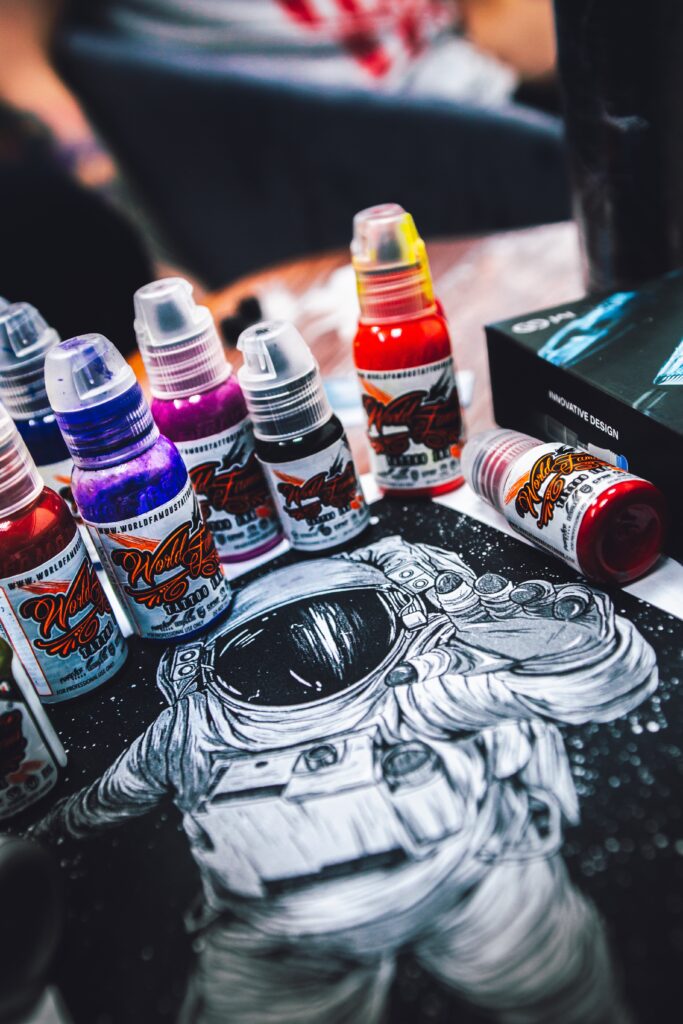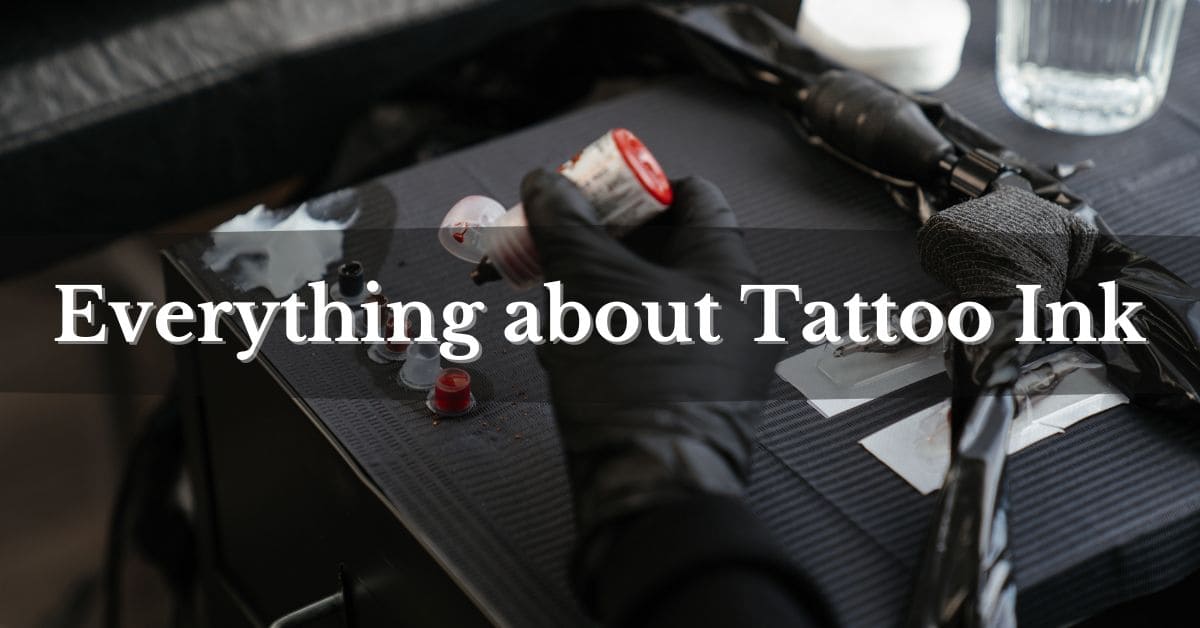Introduction: The Artistry of Tattoo Ink
Tattoos have evolved from being mere symbols of rebellion to becoming intricate works of art that showcase individuality. Behind every stunning tattoo lies the importance of tattoo ink. It is an essential element in the art of tattooing. The colorful medium that allows tattoo artists to create intricate designs and vibrant masterpieces on the skin. If you’re curious about ink and want to understand its various aspects, this is for you. In this article, we will explore the different types of tattoo ink, safety considerations, and provide valuable insights into the world of tattooing.

Understanding Tattoo Ink
It is a pigment that is injected into the skin using a needle, resulting in a permanent design. It is essential to understand that this ink is different from other types of inks used in printing or writing. The composition of tattoo ink plays a vital role in the longevity and vibrancy of the tattoo. Let’s delve deeper into the key aspects of tattoo ink.
The Artistry and Symbolism of Tattoo Ink
Tattoos have evolved beyond mere body decorations and have become a medium for self-expression and storytelling. It plays a crucial role in the artistry and symbolism behind tattoos. Here are some key aspects to consider:
- Custom Designs: Tattoo artists work closely with their clients to create unique designs that reflect their personalities, interests, or life stories. The choice of ink colors and shading techniques contributes to the overall aesthetic and emotional impact of the tattoo.
- Cultural Significance: Tattoos have deep cultural meanings in various societies worldwide. The use of specific tattoo ink colors or symbols can carry cultural or spiritual significance. For example, traditional Japanese tattoos often incorporate vibrant colors and intricate designs with rich symbolic meaning.
- Cover-Up Tattoos: It can also be used strategically to cover up existing tattoos or scars. Skilled tattoo artists utilize a combination of colors and techniques to transform an old tattoo into a new design or hide imperfections.
- Geometric Tattoos: Geometric tattoos feature intricate patterns, symmetrical shapes, and precise linework. Artists utilize solid black ink and precise dotwork to achieve stunning geometric precision.
- Realism and Abstract Styles: It can be employed to create realistic representations of objects, animals, or people. On the other hand, abstract styles explore unconvention
Composition of Tattoo Ink
The ink comprises various ingredients carefully blended to create a stable and long-lasting product. The exact composition can vary among manufacturers, but most tattoo inks consist of the following basic components:
- Pigments: The pigments are the colorants that give tattoos their distinct hues. They can be organic or inorganic compounds. Organic pigments are derived from natural sources, such as plants or minerals, while inorganic pigments are synthetic and created in a laboratory. Common pigments used in tattoo inks include carbon black, titanium dioxide, and iron oxide.
- Carriers: Carriers are liquids that help to suspend the pigments and facilitate their application into the skin. They ensure smooth and even distribution of the ink during the tattooing process. The most common carrier used in tattoo inks is distilled water, although glycerin and alcohol-based solutions are also used.
- Additives: Additives are substances added to tattoo ink to enhance certain properties, such as ink flow, color consistency, and shelf life. They may include preservatives, stabilizers, or even anti-bacterial agents. Additives help to maintain the integrity of the ink and ensure its quality throughout its shelf life.
Types of Tattoo Ink
The ink comes in various types, each with its unique characteristics and qualities. Here are some popular types:
Traditional Tattoo Ink
Traditional ink is made from organic materials, such as carbon-based pigments. People are using it for centuries and is famous for its rich, bold colors. Traditional ink is a popular choice for classic tattoo styles, such as American traditional tattoos.

Watercolor Ink
Watercolor ink is a newer addition to the tattooing world. The design of it is to mimic the appearance of watercolor paintings, featuring soft, delicate hues and blending effects. Watercolor ink can be challenging to work with, requiring a skilled artist to achieve the desired effect.

UV Tattoo Ink
UV ink is a type of ink that glows under ultraviolet light. It is invisible under normal lighting conditions, making it a popular choice for individuals who want a tattoo that remains hidden until exposed to blacklight. Use UV ink with caution and only by experienced artists.

White Ink
White tattoo ink creates subtle highlights and shading in tattoos. It can also be used on its own to create striking white ink tattoos. However, it is important to note that white ink may fade over time and may not be suitable for all skin tones.
Blacklight Ink
Blacklight ink is another type of ink that reacts to ultraviolet light. It appears as a subtle glow under blacklight and can add an intriguing element to your tattoo. Blacklight ink is compatible with the combination of traditional ink to create hidden designs or accents.
Metallic Ink
Metallic tattoo ink contains reflective particles that create a shimmering or metallic effect on the skin. It adds a touch of glamour and uniqueness to tattoos, particularly when used for intricate designs or lettering

Understanding Tattoo Ink Colors
Tattoo ink comes in a vast array of colors, allowing for endless creative possibilities. Each color carries its own significance and can evoke different emotions or convey specific messages. Here are some popular ink colors and their meanings:
- Black: Black ink is the most common choice for tattoos. It symbolizes strength, power, and mystery. Black is often used for outlining, shading, and creating bold designs.
- Red: Red ink is associated with passion, love, and energy. It can be used to depict intense emotions or add vibrant accents to a tattoo.
- Blue: Blue ink represents calmness, tranquility, and spirituality. It is often used in designs related to water, the sky, or spiritual themes.
- Green: Green ink is connected to nature, growth, and renewal. It can be used to depict plants, animals, or symbols of fertility.
- Yellow: Yellow ink represents happiness, optimism, and creativity. It can add a vibrant touch to floral or sunny-themed tattoos.
- Purple: Purple ink symbolizes royalty, spirituality, and mystery. It is often used in designs with a mystical or regal theme.
Choosing the Right Tattoo Ink
Selecting the right ink is crucial for both artists and enthusiasts. Consider the following factors when making your choice:
Quality and Safety
Opt for high-quality tattoo machine & tattoo inks from reputable manufacturers. These inks undergo rigorous testing to ensure they are safe, sterilized, and free from harmful contaminants. Always prioritize the health and well-being of your clients.
Color Selection
Tattoo ink comes in a vast array of colors, allowing artists to create stunning and intricate designs. From bold and vibrant shades to subtle and muted tones, the color selection should align with the desired aesthetic and personal preferences.
Longevity
Long-lasting tattoos are a testament to the skill and quality of the ink. Look for inks that are known for their durability and resistance to fading. This ensures that the tattoo remains vibrant and retains its original allure for years to come.
Compatibility
Different tattoo inks work best with specific skin types. Artists should consider the skin tone, texture, and sensitivity of their clients when choosing tattoo inks. Testing a small patch of ink on the skin beforehand can help determine if any adverse reactions may occur.
Safety Considerations
When getting a tattoo, it’s essential to consider the safety aspects of it. Here are some important factors to keep in mind:
Ink Quality
Always ensure that the ink used is of high quality and meets safety standards. Reputable tattoo studios prioritize the use of professional-grade ink that has been tested for safety and quality.
Sterile Practices
Tattoo artists should follow strict sterile practices to minimize the risk of infection. This includes using single-use needles, disposable gloves, and sterile ink caps. Make sure the studio you choose adheres to these practices.
Allergies and Sensitivities
Some individuals may have allergies or sensitivities to certain tattoo ink ingredients. If you have a known sensitivity, inform your tattoo artist beforehand to avoid any adverse reactions. Conduct Patch tests to check for allergic reactions.
Aftercare Instructions
Proper aftercare is crucial to ensure the healing and longevity of your tattoo. Follow the aftercare instructions provided by your tattoo artist to minimize the risk of complications and maintain the vibrancy of your tattoo.
Tips: In this website You can also find necessary tattoo aftercare guideline, Tips & tricks everything you want to know about.
Safety & Regulations
The safety of tattoo ink is a significant concern for both artists and enthusiasts, nonetheless to you if are thinking about a tattoo now. It’s crucial to ensure that the ink used is safe and meets regulatory standards. It is subject to regulations and guidelines set by health authorities in different countries. These regulations aim to ensure the safety and quality of tattoo inks.
FDA Regulations
In the United States, the Food and Drug Administration (FDA) regulates tattoo inks as cosmetics. However, it’s important to note that the FDA does not approve specific tattoo inks or pigments. Instead, they provide recommendations and guidelines for manufacturers to ensure their products meet certain safety standards.
European Union Regulations
In the European Union, tattoo inks fall under the scope of the EU Cosmetics Regulation. Tattoo inks and pigments must comply with strict safety requirements, including being free from certain substances that may pose risks to human health. The European Chemicals Agency (ECHA) evaluates and authorizes ink ingredients before they use it in the EU market.
FAQs (Frequently Asked Questions)
Tattoo ink is generally safe for most individuals. However, some people may have allergies or sensitivities to certain ink ingredients. It’s important to discuss any concerns or known allergies with your tattoo artist before inking.
Mixing tattoo inks is a common practice among experienced tattoo artists. It allows them to create custom colors and achieve unique effects. However, it’s essential to ensure that the inks are compatible and safe to mix.
Yes, It is designed to be permanent. It is injected into the dermis, the second layer of the skin, where it remains intact for years. However, over time, tattoos may fade or change due to factors such as sun exposure, aging, or improper aftercare.
While It is designed to be permanent, there are tattoo removal procedures available, such as laser tattoo removal. However, complete tattoo removal may not always be possible, and the process can be costly and time-consuming.
Yes, there are tattoo inks formulated with special pigments that glow in the dark. These inks absorb and store light, emitting a glow in low-light conditions.
Some individuals with sensitive skin may opt for temporary tattoos or henna tattoos as alternatives to permanent ink. These options allow them to experiment with different designs without the commitment of a permanent tattoo
Conclusion
The Ink of Tattoo is the artistic medium that allows artists to create stunning and meaningful designs on the skin. Understanding the composition, types, safety considerations, and aftercare of it is essential for both enthusiasts and individuals considering getting a tattoo. By staying informed and making educated choices, you can ensure a positive tattoo experience that reflects your personal style and individuality.
Remember, getting a tattoo is a personal decision, and it’s important to choose a reputable tattoo artist who prioritizes safety and maintains high standards of professionalism. So, if you’re ready to embark on your tattoo journey, it is essential to take the time to research diligently. By doing so, you can find the perfect tattoo artist who will skillfully and creatively bring your vision to life.
